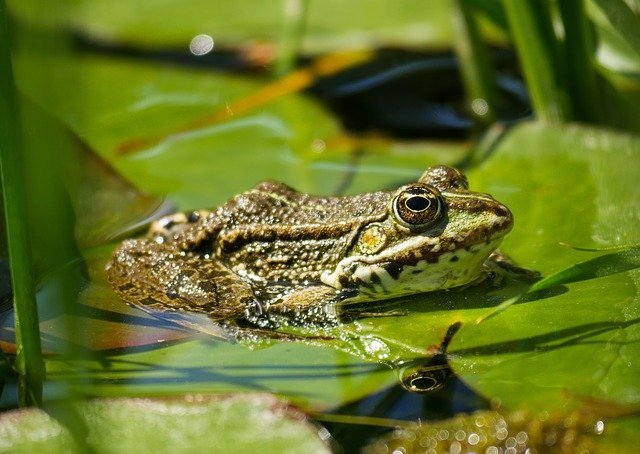The green tree frog is a nocturnal, arboreal amphibian that lives in wetlands. They’re found near small bodies of water like ponds and lagoons. In the United States, they primarily live in the southeast, native to Florida, reaching as far north as Maryland and west as central Texas.
What Does Nocturnal Mean?
Nocturnal refers to active animals at night and dormant during the day. The opposite of nocturnal is diurnal. Nocturnal animals have particular evolutionary and behavioral traits that allow them to function well in darkness.
Reasons Why Animals Are Nocturnal
A nocturnal lifestyle has its advantages. Many animals have evolved into nocturnal creatures to give them a leg up in their night-to-night lives:
- Fewer of their natural predators will be hunting for them.
- If the prey they hunt is also nocturnal, they’ll have more food options.
- While they hunt, their prey won’t as quickly be able to detect their presence.
- There is less overall competition for resources between all of the ecosystem’s animals
By living on an opposite schedule to too many of their neighbors, nocturnal animals can reduce instances of competitive and dangerous situations.
Why Are Green Tree Frogs Nocturnal?
Humid Conditions
Since frogs are amphibians, they best thrive in moist and humid environments. In general, nighttime air is more humid and allows for water conservation. Green tree frogs will be most active on warm, rainy nights for this very reason.
Fewer Predators
Green tree frogs’ natural predators include snakes, lizards, birds, and large fish. Some of these animals are, in fact, diurnal (active during the day). Following a nocturnal schedule, the frogs eliminate the risk of being hunted while going about their nightly routine.
This is specifically important when it comes to the mating season. Frogs can breed relatively safely because they do so at night.
Nocturnal Prey
Tree frogs are insectivores. While bugs are around during the day, there are way more out at night. This allows the frogs to find food sources easily.
Living in the Dark
Nocturnal animals have marked differences compared to their daily counterparts, like humans. Green tree frogs have specially evolved traits that make navigating in darkness a habitual way of life.
Keen Eyesight
Researchers have found that nocturnal frogs have some of the best night vision in the entire world. They can often see spectrums of light way beyond what we humans can see, like high-energy visible light (blue light) and into ranges of ultraviolet light.
Frogs can even see color in darkness, recently discovered in a 2017 research study. Whereas human eyes have rods with one level of sensitivity, frog eyes have rods with two sensitivities. In environments where humans would not be able to see a thing, nocturnal frogs can not only see well, but they can still see in color.
Night-frog vision has evolved out of necessity. Green tree frogs often find themselves in near-complete darkness. Their routine is to hide in dark, enclosed places.
Hunting Abilities
Green tree frogs also have developed visual capabilities to help them detect prey in darkness. When they hunt, they stand completely still and wait for bugs to come near. Their eyes are motion-sensitive and can see the insects’ movements, even in extreme darkness.
Researchers have also found that nocturnal frogs utilize their low-light color vision while they hunt. This could be another way they can see insects that might otherwise blend into the background of the night.
Croaks and Calls
Green tree frogs have many different calls depending on their purpose, including warning croaks, mating croaks, and rings that are signs of stress and danger. Only the males croak.
Green tree frogs also exhibit a few crepuscular behaviors. Crepuscular refers to active animals at dawn and dusk, originating from the Latin word for “twilight.”
Green tree frogs begin croaking at dusk. These twilight calls are territorial, meant to warn other males to stay away. As night sets in, male frogs will advance toward the breeding pool.
It’s worth clarifying that while the frogs begin their activities at dusk, they are undoubtedly nocturnal creatures.
Mating
Green tree frogs mate once it’s dark. They’re primarily solitary animals, living above the forest floor in vegetation and trees where they can avoid awkward social interactions and dangerous encounters with predators. But they will come down from their perches to mate under nighttime protection.
What Do Green Tree Frogs Do During the Day?
After all of those nightly taxing activities, some downtime is in order. When the sun rises, green tree frogs will retreat to safety and relax. They’ll hide and sleep in shady, moist locations near water. Undersides of leaves and crevices of logs are safe places for the frogs to hide away from their diurnal predators.
The frogs’ green color allows them to blend in with the surrounding vegetation, making them less visible to predators. This is known as concealing coloration camouflage.
How Light Pollution Affects Nocturnal Patterns
Light pollution is an artificial light that interrupts natural global characteristics like star visibility, energy usage, and ecosystem norms. Examples include distant city lights and porch lights in rural areas.
Research has shown that light pollution negatively affects nocturnal animals like the green tree frog.
Artificial light from nearby homes and cities lessens or eliminates male calls for mates. As a result, many frog populations have been reduced in recent years.
Tadpoles need a certain amount of true darkness to healthfully develop into adult frogs, which are being interrupted more frequently because of light pollution.
Streetlights are often places where frogs will congregate because they’ve figured out that insects are attracted to the light. While this helps the frogs hunt, it also exposes them to danger in high-traffic areas.
Nighttime Naturals
Green tree frogs possess fascinating abilities, their lives beating to a nocturnal rhythm. Aces of acute vision and masters of daytime disguise, these amphibious critters were made for the darkness.




